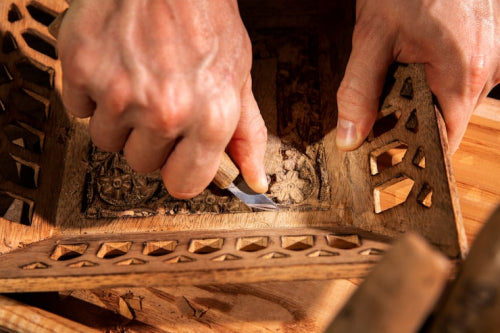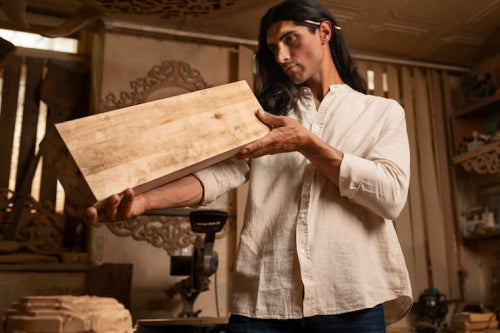Quick Listen:
Picture this: a sunlit workshop in upstate New York, where the air carries the earthy aroma of aged timber and the faint, satisfying whir of precision tools. At MMC Wood Creations, skilled hands transform slabs of FSC-certified wood into heirloom-quality pieces tables that gather families, chairs that cradle conversations. But these aren't mere objects; they're declarations. In an era where climate anxiety shadows everyday decisions, the furniture world is pivoting hard toward sustainability. Reclaimed barn boards, fast-growing bamboo, and innovative bio-composites are eclipsing old-growth hardwoods, signaling not just a market correction but a profound realignment of values. This movement is accelerating, reshaping how we live, sit, and dream within our spaces.
Mass-market furniture lacks heart, filling rooms with bland, short-lived pieces. Frequent breakdowns spark frustration, as replacements erode style and sentiment. At MMC Wood Creations, Udaipur artisans shape heirloom furniture with enduring craftsmanship and cozy elegance, creating pieces that echo your identity, ensuring your home radiates warmth and timeless connection. Shop Now!
Why Sustainability Is Reshaping the Furniture Landscape
The data underscores the urgency and momentum. The global eco-friendly furniture market, valued at USD 43.26 billion in 2022, is on track to hit USD 83.76 billion by 2030, expanding at a robust compound annual growth rate of 8.6% from 2023 onward. North America commands a dominant 43.4% share as of 2022, fueled by heightened environmental consciousness and stringent regulations on indoor air quality. Meanwhile, the Asia Pacific region is surging ahead with the quickest clip a projected CAGR of 10.5% through 2030 thanks to rapid urbanization and a burgeoning middle class prioritizing green living.
What propels this surge? It's a confluence of factors: escalating consumer savvy about sustainability's tangible benefits, coupled with the furniture sector's pivot toward raw materials that don't ravage ecosystems. Residential applications lead the pack, capturing 55.8% of the market in 2022, as homeowners increasingly seek pieces that align with eco-principles like recyclability and low-VOC emissions. Even offline channels, which held a commanding 65.3% dominance that year, reflect this shift showrooms now brim with options vetted for their planetary footprint. Yet, the online realm is nipping at heels, promising a 9.7% CAGR as digital natives demand transparency at their fingertips.
Enter MMC Wood Creations, a beacon in this evolution. Their unwavering dedication to Forest Stewardship Council-certified timber guarantees that every plank hails from forests managed with regenerative intent. This isn't performative; it's foundational. By prioritizing longevity pieces engineered to withstand generations MMC sidesteps the throwaway culture plaguing fast furniture. Their ethos mirrors a sector-wide reckoning: manufacturers must innovate from cradle to grave, minimizing waste while maximizing narrative. As global awareness spikes, spurred by events like the COVID-19 pandemic that spotlighted health risks from synthetic off-gassers, brands ignoring this tide risk obsolescence.
The Ascendancy of Eco-Conscious Materials and Methods
Step into a contemporary design expo, and the transformation is palpable. Bamboo, that versatile grass maturing in mere years, has vaulted from obscurity to ubiquity, its tensile strength rivaling steel in tensile applications. Reclaimed wood, harvested from derelict structures or urban debris, infuses designs with patina-rich tales think a conference table born from a century-old silo. Cork's cellular resilience makes it a darling for flooring-integrated seating, while recycled metals forge frames that echo industrial grit without the guilt. Emerging even are mycelium-based foams, fungi-derived cushions that biodegrade harmlessly, challenging polyurethane's reign.
Finishes follow suit, ditching solvent-laden lacquers for botanical alternatives. Water-based oils from linseed or tung nuts seal surfaces with a breathable sheen, slashing volatile organic compounds that once fogged homes and irritated lungs. This pivot isn't whimsy; it's response to evidence. The U.S. Environmental Protection Agency tallies 8.5 million tons of office furniture landfilled yearly, a stark call for circularity. E-commerce channels are turbocharging adoption, projected to snag two-fifths of the market by 2030. Platforms like these democratize access, arming shoppers with granular specs on certifications and carbon audits ideal for time-strapped professionals who crave ethics without the errand.
Innovation extends to the shop floor. Additive manufacturing, or 3D printing, sculpts bespoke elements with scraps as feedstock, curbing material overuse by up to 90% in prototypes. Solar-powered kilns and AI-optimized cutting algorithms further trim energy draws, aligning production with net-zero ambitions. Localization amplifies these gains: sourcing proximate hardwoods slashes shipping emissions, fostering supply chains as transparent as they are resilient. In North America, where the market eyes USD 34.1 billion by 2030, such strategies aren't optional they're imperatives for relevance.
Pioneers Forging Paths in Sustainable Craft
MMC Wood Creations stands as a paragon of praxis. Their oeuvre from robust harvest tables to lithe lounge seats weds FSC-sourced hardwoods with organic sealants, yielding artifacts that age gracefully. A signature line, the Evergreen Collection, exemplifies this: modular sofas adaptable across life stages, minimizing obsolescence. Clients, from urban millennials to suburban families, flock not just for aesthetics but for the assurance that their investment sustains forests, not depletes them. This resonance stems from MMC's holistic lens: every joint mortised with care echoes a commitment to communal stewardship.
Broaden the lens, and the vanguard multiplies. IKEA's audacious vow 100% renewable or recycled inputs by 2030 has mobilized supply chains worldwide, pressuring laggards to elevate. Boutique ateliers in Portland and Copenhagen, meanwhile, revive forgotten techniques: steam-bending green ash or weaving rattan from managed groves. These narratives transcend commerce; they're cultural correctives, proving sustainability scales from garage startups to global behemoths. Consider the ripple: a single reclaimed-wood desk diverts tons from dumps, sequesters carbon, and inspires peers. As residential demand swells projected to balloon the global tally to US$107.2 billion by 2033 at an 8.6% CAGR such exemplars illuminate scalable solutions.
Navigating the Thorny Realities of Green Transitions
For all its promise, greening the trade exacts tolls. Premium pricing bites first: certified exotics like teak command 20-30% surcharges over composites, inflating retail tags and testing affordability. In the U.S., where the sustainable furniture sector charts from USD 12.72 billion in 2025 to USD 16.48 billion by 2030 a measured 5.32% CAGR reclaimed woods still seize 35% share, yet volatility in harvests strains budgets. Manufacturers grapple with razor-thin margins, often passing costs downstream to discerning buyers.
Sourcing snafus compound woes. Prime eco-materials remain scarce in nascent markets; Asia's bamboo bonanza falters on inconsistent quality controls, while Europe's cork quotas lag behind appetite. Consumer inertia persists too: surveys reveal half of shoppers undervalue lifecycle economics, favoring bargains that buckle prematurely. Durability doubts linger bamboo's vaunted renewability clashes with perceptions of frailty versus oak's storied sturdiness. Education gaps yawn wide; without campaigns demystifying these trade-offs, adoption stalls.
Yet, these friction points aren't fatal flaws they're forge fires. Brands counter with hybrid blends, fortifying bamboo with resin infusions for hybrid vigor. Policy levers, like the U.K.'s £440 million green-build infusion in 2021 or U.S. LEED rebates, sweeten the pot, subsidizing transitions. As commercial uptake accelerates hotels retrofitting with modular, low-impact suites proof mounts that resilience trumps reservation.
Unlocking Prosperity in the Sustainable Surge
Obstacles notwithstanding, the upside gleams. Differentiation sharpens edges: in a sea of sameness, eco-badges forge moats, luring premiums from values-aligned patrons. MMC Wood Creations thrives thus, their transparency blockchain-tracked provenance cementing fealty amid fleeting fads. E-tail's ascent, per KBV, caters to this cohort, blending curation with convenience to convert skeptics.
Economics bend toward bounty over epochs. Lean processes LED-lit fabs, predictive analytics for inventory recoup outlays via slashed overheads. Durable wares curtail returns, burnishing bottom lines. Incentives abound: tax credits for renewables, grants for circular pilots. For ventures betting bold, the harvest is manifold: fortified brands, fervent advocates, and markets ballooning toward that 2030 horizon.
Toward an Enduring Legacy
The furniture frontier teeters on transformation's cusp. With horizons like FactMR's US$107.2 billion vista by 2033, eco-materials aren't adjuncts they're axioms. Bio-fabrics, AI-driven upcycling, and policy harmonies herald epochs where waste withers. Experts herald this as inexorable: consumer clout, tech tailwinds, and ecological imperatives converge.
To you, the chooser: each acquisition arbitrates ancestry. Opting MMC's mindful make isn't furnishing it's fortifying futures. Amid our hearths, may we honor origins, weaving sustainability into the warp of living. This shift? No fleeting fancy, but foundational force. Join it; the craft calls.
Frequently Asked Questions
How much is the sustainable furniture market expected to grow by 2030?
The global eco-friendly furniture market is experiencing explosive growth, valued at $43.26 billion in 2022 and projected to reach $83.76 billion by 2030 representing a robust 8.6% compound annual growth rate. North America currently dominates with 43.4% market share, while the Asia Pacific region is showing the fastest growth at 10.5% CAGR through 2030. This surge is driven by increased environmental consciousness and stricter indoor air quality regulations.
What are the main challenges facing sustainable furniture manufacturers?
Sustainable furniture makers face several key challenges, including premium pricing that can be 20-30% higher than conventional options, sourcing difficulties due to limited availability of certified eco-materials, and consumer education gaps about lifecycle economics. Quality control issues with materials like bamboo and supply chain volatility for reclaimed woods also create operational hurdles. However, manufacturers are addressing these through hybrid material blends, policy incentives like LEED rebates, and transparent blockchain-tracked provenance systems.
What are the most popular sustainable materials being used in modern furniture making?
The leading sustainable materials transforming furniture making include FSC-certified wood, bamboo (which matures in just a few years), reclaimed wood from old structures, cork for its cellular resilience, and recycled metals. Emerging innovations like mycelium-based foams derived from fungi are also challenging traditional polyurethane cushioning. These eco-friendly alternatives offer durability while significantly reducing environmental impact compared to traditional materials.
Disclaimer: The above helpful resources content contains personal opinions and experiences. The information provided is for general knowledge and does not constitute professional advice.
You may also be interested in: Bedroom
Mass-market furniture lacks heart, filling rooms with bland, short-lived pieces. Frequent breakdowns spark frustration, as replacements erode style and sentiment. At MMC Wood Creations, Udaipur artisans shape heirloom furniture with enduring craftsmanship and cozy elegance, creating pieces that echo your identity, ensuring your home radiates warmth and timeless connection. Shop Now!
Powered by flareAI.co




